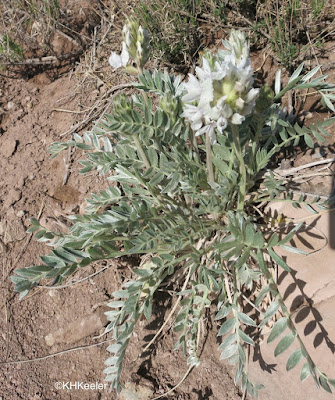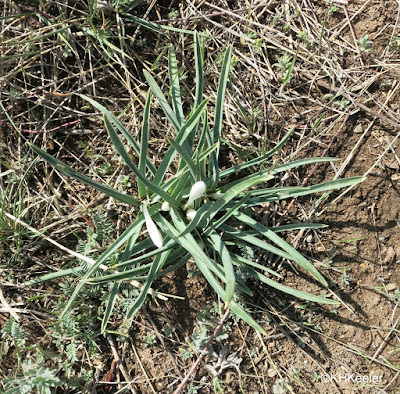 |
| Plants seen along the Devil's Backbone Trail, Loveland, Colorado |
Well, that is one way to say it. Another is that the cool temperatures extended the visibility of the early flowers.
Usually when I first make it along the Rocky Mountain foothills trails, sand lily, Leucocrinum montanum, also called the star lily (in the yucca and agave part of the big asparagus family Asparagaceae, no longer classified in the lily family) has just finished flowering and flowers are wilting.
But they were wide open--in full flower--and easy to spot this April 25th.
 |
| sand lily or star lily, Leucocrinum montanum flowers about 2" in diameter, leaves about 5" long |
I think of early spring as the flowering time of mustards (cabbage family, Brassicaceae), and it is, but I saw only one (the tiny weed Alyssum simplex, see photo link) perhaps because the common ones are European weeds which do not do well along unwatered rocky Colorado trails.
What I did see were two early spring native plants in the carrot family, the Umbelliferae or Apiaceae, the umbels. They were small. If bigger brighter flowers had been out, they would have gotten no attention.
But, look, this is salt and pepper, Lomatium orientale
 |
| musineon, Musineon diverticulata |
All three of these little umbels, Lomatium, Musineon and Harbouria, are called by some sources "wild parsley." All three are edible in the sense of being non-poisonous. However, two of the most poisonous plants in North America are also umbels, poison hemlock and water hemlock. Those can kill you. (A gallery of umbel photos link) So likely someone called these plants parsleys as a description to help identify them, not as an invitation to taste. There are several good characters that differentiate the wild parsleys from their poisonous relatives, but if you are inclined to nibble, try them first in the company of an expert.
Dandelions, Taraxacum officinale, the common lawn weed, were flowering around the parking lot and at the trail head. I decided I didn't need another dandelion photograph.
But somewhere out the trail, I looked a second time at the dandelion, and it was a false dandelion, Agroseris glauca (dandelion family, Asteraceae), also called pale agroseris and mountain dandelion, a Colorado native. It looks like a common dandelion until you look closely and check the leaves. The leaves don't have same kind of teeth as a common dandelion leaf.
 |
| false dandelion, mountain dandelion, Agroseris glauca |
 |
| wavy-leafed dandelion, Nothocalais cuspidata, flower just opening |
The bigger showier flowers will be out soon. In the photo below is the one white locoweedOxytropis sericea (pea family, Fabaceae) that I saw with open flowers. Locoweeds, and a number of related plants, are toxic to people and livestock. For cattle and horses, the poisoning begins with lethargy, develops to staggering and eratic (loco) behavior, and can lead to death. The toxin acts on the nervous system and getting the animal onto a better diet will often reverse the damage. Part of the problem, apparently, is that the locoweeds taste ok, so animals will happily eat too much.
 |
| white locoweed, Oxytropis sericea This plant is easily 3x the size of any of the others in this post. So, 3x the size of a healthy (but not huge) common dandelion plant. |
My guess would be that since the growing seaon is just starting, so this is as big as they've had time to grow since the temperatures became mild. Not that these particular plants will ever be bigger, but the group of plants that flower first put out small flowers from small plants. They don't have the reserves for bigger flowers and if they waited, other plants would overtop them and no pollinators would see their flowers. And also, perhaps, if a late blizzard freezes these flowers, the plant will have some resources left to send up another modest flower stalk.
Also obvious in my photos is that the flowers I saw were yellow and white. Why?
One explanation would be that the early spring pollinators, bees and flies, are attracted to those colors. And probably they make a good contrast against a mostly brown environment (see photo below). But also, those are colors that reflect back heat from sunlight. A yellow or white flower will be just a bit warmer than the air, as has been shown in high mountain plants, and is important to insects at the beginning of spring.
 |
| Doesn't look very interesting, but all the plants above were found there. |
The spring moves fast. Three other species had many plants in flower along this same route yesterday. The ones in this blog post are increasingly going to seed and getting hard to spot. If you miss them, go out early next year.
Comments and corrections welcome.
References
Moerman, Daniel E. 1998. Native American Ethobotany. Timber Press, Portland Oregon. Online http://naeb.brit.org
References
Moerman, Daniel E. 1998. Native American Ethobotany. Timber Press, Portland Oregon. Online http://naeb.brit.org
Seebeck, Cattail Bob. 1998. Best-Tasting Wild Plants of Colorado. Westcliffe Publishers, Englewood, Colorado.



No comments:
Post a Comment